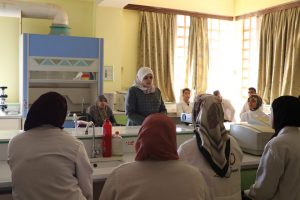A master’s thesis in the College of Science at the University of Kerbala has discussed the evaluation of the therapeutic role of gold nanoparticles on some physiological and histological parameters of male rats induced by streptozotocin, by a student Hadeel Hamid Sajit and under the supervision of the Dean of the College of Science, Assistant Professor Dr. Jassem Hanoun Hashem, and the presence the scientific and administrative assistants and the head of the Department of biology. The study aims to test the therapeutic effect of gold nanoparticles on diabetic nephropathy in rats induced with diabetes by using streptozotocin by inducing diabetes in experimental groups as well as determining the optimal dose of gold nanoparticles for the treatment of induced diabetic rats using more than one dose and analyzing some blood parameters (glucose, total cholesterol, triglycerides and creatinine level). Tissue sections of the liver, kidney and pancreas were taken to study the histological changes and compare them with the control group for all studied groups.
The study has concluded that the therapeutic role of gold nanoparticles showed a significant decrease in the levels of cholesterol, triglycerides and blood sugar, as well as the use of streptozotocin, which led to a general increase in the percentage of body fat, blood glucose and creatinine in the experimental rats and the occurrence of many histological changes in diabetic nephropathy Which was treated with gold nanoparticles, where the induction of diabetes led to many tissue damages in the tissue of the kidney, liver and pancreas. It was possible to improve the image of the liver, pancreas and kidney, and the tissue structure of them restored their normal status. The study has recommended the adoption of the study of the effect of other types of nanoparticles such as silver and zinc nanoparticles on the groups of laboratory mice induced by diabetes. As well as the synthesis of gold nanoparticles by the biological method such as using plant or bacterial extracts and studying their impact and knowing their difference from the chemical method and taking tissue sections of other organs such as the brain to know the concentration ratio of particles Gold nanoparticles in it and the extent of its impact and conducting some studies at the molecular level to know the effects of both stz and gold nanoparticles on the genetic material of liver and kidney cells.
































































